From August 2023 the comments on statistics, a short description of selected, recently issued statistical data in the area of monetary statistics and the non-residents sector statistics, are no longer published. They are replaced by Statistical releases.
Comments on the balance of payments, gross external debt and the international investment position in 3Q 2022
The strong growth of tourism revenues in the third quarter neutralised the impact of expensive raw materials and energy products on the widening of the goods deficit. As a result, the current and capital account surplus in the balance of payments was only slightly lower than in the same period of the previous year. However, due to the prevalence of these unfavourable effects in the first half of the year, the cumulative surplus in the current and capital account decreased sharply in the last four quarters from 2021.
As shown in the current account, a noticeable net outflow was observed in the financial account of the balance of payments, which, together with the growth in nominal GDP, contributed to a noticeable improvement in the relative indicators of external debt and the international investment position.
The current and capital account of the balance of payments ran a surplus of EUR 4.5bn in the third quarter of 2022, which is a deterioration in the balance of EUR 0.1bn from the same period of the previous year (Figure 1a). The lower balance was due to the strong increase in the foreign trade deficit, mostly driven by a marked increase in net imports of energy products following sharp increases in their prices in the global market. Unfavourable trends in the trade in goods were entirely mitigated by the increase in net exports of services, particularly by the growth in revenues from tourism consumption of non-residents which trended up by almost 28% in the third quarter of 2022 from the same period of the record tourist year of 2019. In addition, the deficit in the primary income account widened slightly, while the overall surplus in the secondary income and capital accounts remained at the same level as in the third quarter of 2021. However, due to the prevalence of adverse effects in the first half of the year, primarily a pronounced rise in net imports of energy products, the cumulative current and capital account surplus decreased sharply in the last four quarters, standing at 0.9% of GDP in the period up to the end of September 2022, compared with 4.2% of GDP in the whole of 2021.
Figure 1 Balance of payments
| a) Current and capital account | b) Financial account |
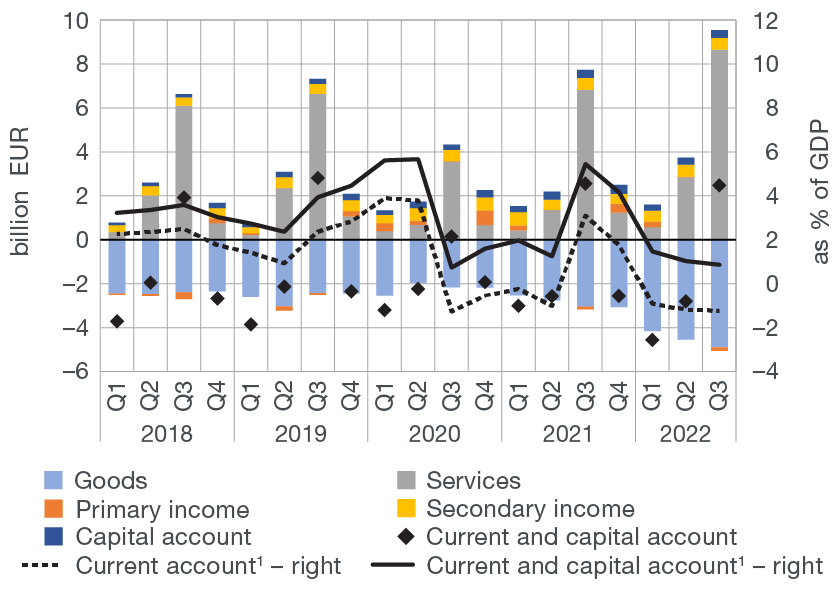 |
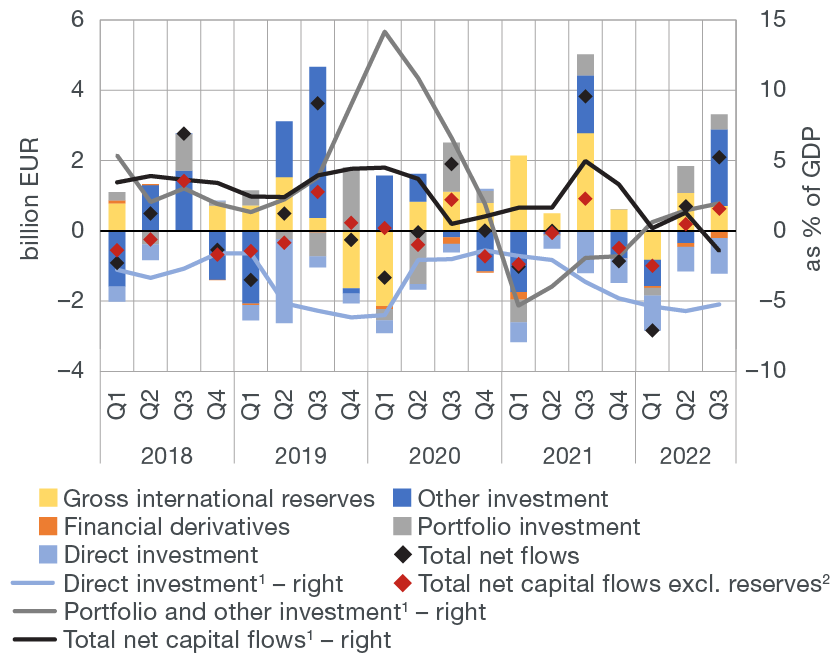 |
1 Sum of the last four quarters.
2 Excluding the change in the gross international reserves and foreign liabilities of the CNB.
Note: In the figure showing the financial account, the positive value denotes net outflow abroad and the negative value denotes net inflow.
Source: CNB.
The financial account of the balance of payments recorded a net outflow of EUR 2.1bn in the third quarter of 2022, which is a decrease of EUR 1.7bn from the same period of the previous year (Figure 1b). The gross international reserves grew less strongly than in the same period of the previous year on the account of much smaller increase in the government’s foreign currency deposit with the CNB and the fact that a noticeable increase in reserves was observed in the same period of the previous year after the allocation of special drawing rights of the International Monetary Fund (IMF). However, given that the foreign liabilities of the central bank increased by the same amount as a result of this allocation, their impact on the CNB’s net foreign position was neutral. Net outflow, excluding the change in reserves and liabilities of the CNB, was smaller, totalling EUR 1.6bn, which is a decrease of EUR 0.7bn from the third quarter of 2021. This primarily reflects the developments in the sub-account of other investment, i.e. although a noticeable net outflow in the account of other investment was also recorded in the summer months of 2022, due to a strong seasonal improvement in the net foreign position of banks, it was smaller than in the previous year, if the aforementioned effect of liabilities of the CNB is excluded. As a result, banks’ funds within the TARGET2 system managed by the central bank were reduced in the third quarter of 2022, while their level remained unchanged in the same period of the previous year. In addition, net outflow was recorded in the portfolio investment account as a result of a decrease in liabilities arising from government long-term securities due to transactions in the secondary market. However, it was also smaller than in the same period of the previous year. By contrast, net inflow in the direct investment account was somewhat weaker than in the previous year, primarily due to a smaller inflow of direct equity investments in Croatia.
Table 1 Balance of payments

1 Excluding the change in the gross international reserves and foreign liabilities of the CNB. The investment of a portion of international reserves in reverse repo agreements results in a simultaneous change in CNB assets (recorded in the reserve assets account) and liabilities (recorded in the other investment account) and thus has a neutral impact both on changes in the central bank’s net foreign position and the overall financial account balance.
2 Sum of the last four quarters.
Note: The positive value of financial transactions denotes net outflow abroad and the negative value denotes net inflow.
Source: CNB.
The gross external debt was EUR 48.5bn at the end of September 2022, or 74.6% of GDP (Figure 2a), which is a decrease of EUR 1.1bn or 4.8 percentage points of GDP from the end of June 2022, due mostly to the fall in debt of the government and other domestic sectors, including liabilities towards affiliated creditors abroad, and the growth in nominal GDP (Figure 2b).
Figure 2 Gross external debt
| a) Stock of gross external debt | b) Change in gross external debt |
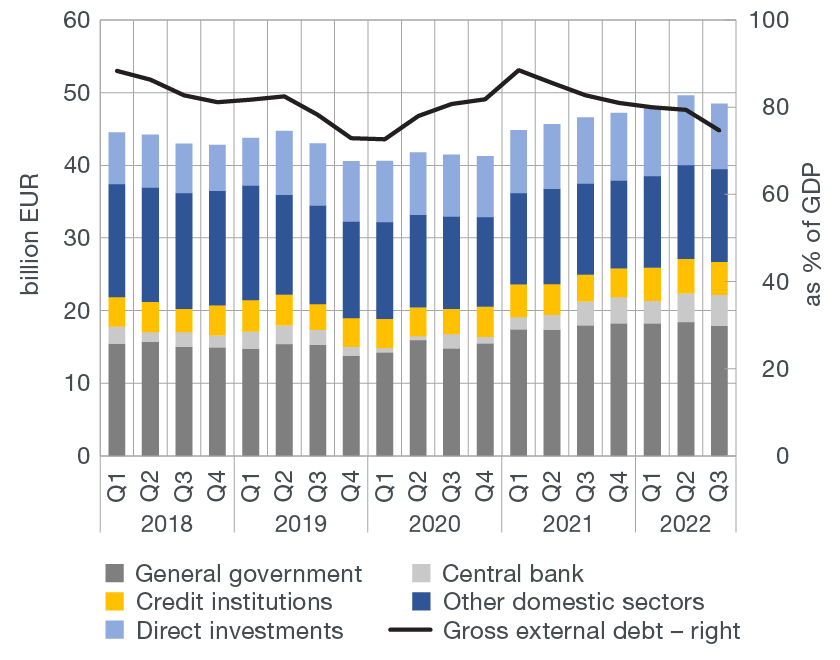 |
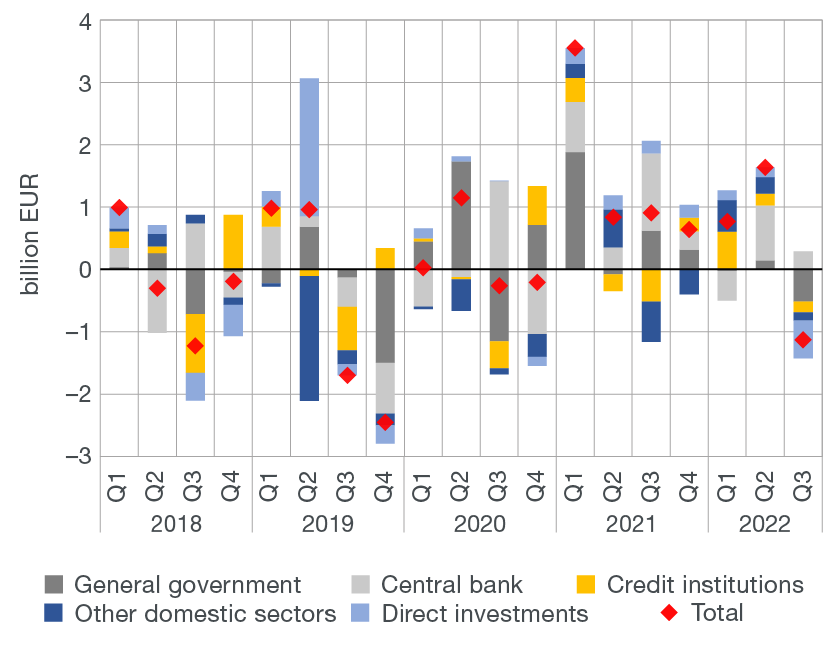 |
Note: Changes in gross external debt are a result of net transactions of domestic sectors and exchange rate and other adjustments.
Source: CNB.
The net external debt fell sharply in the third quarter (by EUR 4.3bn) on the back of the decrease in gross external debt and the strong increase in foreign debt claims of domestic sectors, especially banks. At the end of September 2022, it entered the negative territory for the first time, standing at EUR –0.7bn or –1.1% of GDP. The fall in net external debt led to an improvement in the net international investment position, from EUR –20.4bn at the end of June 2022 to EUR –16.1bn at the end of September (Figure 3a). Accordingly, the relative indicator of the net international investment position improved to –24.8% of GDP at the end of September from –32.7% of GDP at the end of June 2022 (Figure 3b).
Figure 3 International investment position (net)
| a) Position by sector | b) Relative indicator by type of investment |
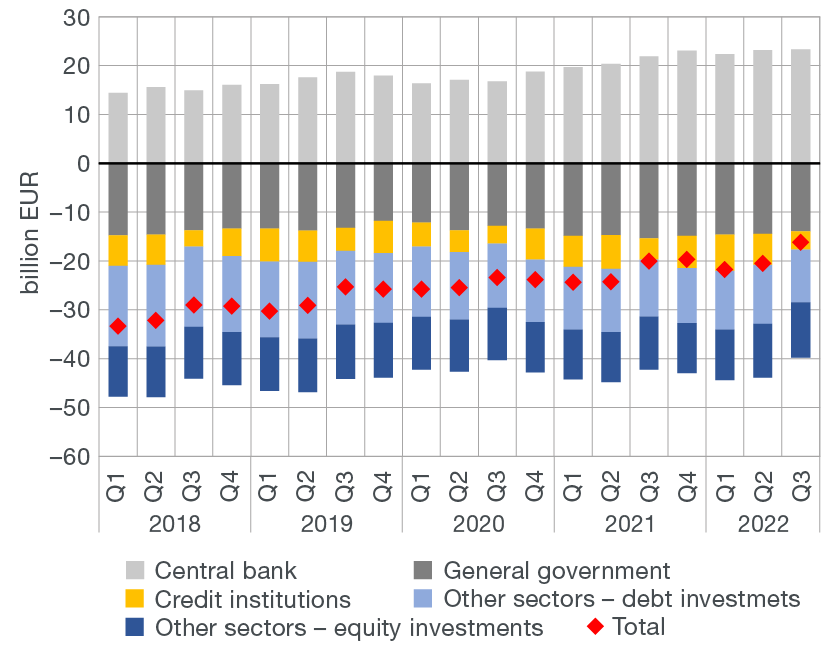 |
 |
Notes: The international investment position (net) equals the difference between domestic sectors' foreign assets and liabilities at the end of a period. The negative value of the net international investment position indicates that foreign liabilities of Croatian residents are greater than their foreign assets. Included are assets and liabilities based on debt instruments, equity investments, financial derivatives, and other instruments. Figure 3b includes financial derivatives and other liabilities in the net debt investment position.
Source: CNB.
Detailed balance of payments data
